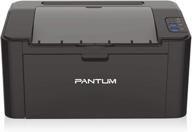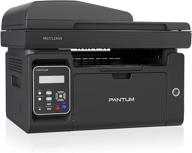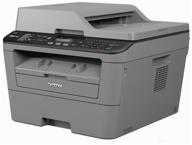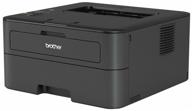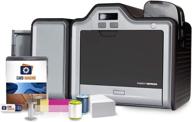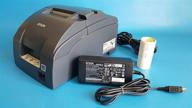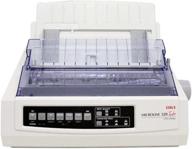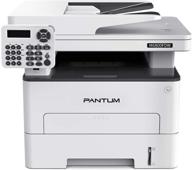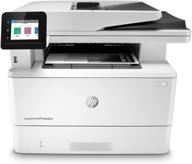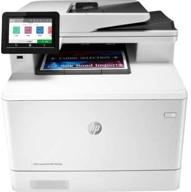High Speed Printing
When looking for a new laser printer, one of the key factors to consider is the print speed. For busy offices that generate high volumes of documents, a fast printer can greatly improve workflow and productivity.
Measuring Print Speed
Print speed is usually measured in pages per minute (ppm). Most laser printers will list both black and white and color print speeds. Some examples:
- 24 ppm black, 24 ppm color - Prints 24 black and white or color pages per minute
- 36 ppm black, 36 ppm color - Prints 36 pages per minute, whether black or color
- 40 ppm black, 20 ppm color - 40 pages per minute in black & white mode, 20 pages per minute in color mode
Faster print speeds generally mean a more powerful printer engine and processor. When comparing models, look for the highest rated print speeds within your budget.
First Page Out Time
Related to overall print speed is the first page out time. This measures how long it takes the printer to process and begin printing the first page of a document after being triggered. For big documents, first page out time will be slower than subsequent pages since the printer needs to process the whole document before printing.
A fast first page out time is crucial for productivity. Even a printer with a high pages per minute rating can be frustrating if you have to wait a long time for printing to start. Look for laser printers with first page out times of 5-10 seconds or less.
Processor and Memory
The print engine speed depends heavily on the processor and memory capabilities. Laser printers designed for fast, high-volume printing will have:
- A fast processor (≥ 1 GHz)
- Plenty of RAM - ≥ 256 MB
- Large onboard storage or hard drive
More powerful processing lets the printer handle complex documents with graphics and photos quickly. More RAM allows spooled print jobs to be processed rapidly. And more storage enables print jobs to be accessed quickly.
Durability for High Page Volumes
Finally, a high speed printer needs to be durable enough to handle thousands of pages per month without breaking down. Look for models designed for high duty cycles of 50,000 pages per month or greater.
Other durable features include metal frames, heavy duty paper trays, and long life consumables such as fuser assemblies and rollers.
With fast print speeds, quick first page out, and heavy duty construction, a high speed laser printer will provide reliable performance even in the busiest office environment.
Fast Page Print Speeds for Busy Offices
For offices that routinely print large volumes of documents, a printer's page print speed is a critical specification to consider. Faster print speeds can greatly improve workflow and reduce wait times for users.
What is Print Speed?
Print speed refers to the number of pages a printer can produce per minute (ppm). Most office laser printers have print speeds measured in two categories:
- Black and white print speed
- Color print speed
Print speed is usually slower when printing in color vs black and white. For maximum productivity, look for a printer with fast rated speeds in both categories.
Typical Print Speeds
| Print Speed | Pages per Minute |
|---|---|
| Low-volume personal printer | 20-30 ppm |
| Medium-volume workgroup printer | 30-40 ppm |
| High-volume office printer | 40-55+ ppm |
For busy offices with high print volumes, 45 ppm or faster for black and white, and 30 ppm or faster for color is recommended.
Factors Affecting Print Speed
The rated print speed depends on several technical factors:
- Print engine design - More powerful engines print faster
- Processor and memory - A faster processor and more RAM improves speed
- First page out time - Time to process and start printing first page
Look for machines optimized for speed with fast processors, lots of memory, and quick first page out times under 10 seconds.
Heavy Duty Print Volumes
A fast printer also needs heavy duty capabilities to sustain high print volumes month after month. Look for features including:
- High monthly duty cycle - 75,000 pages or more per month
- Heavy paper trays and robust paper handling
- High yield toner cartridges to minimize changes
- Durable components like fuser, rollers, gears
With fast speeds and rugged construction, a high speed printer will provide consistent performance even under heavy workloads in the busiest offices.
Key Benefits of Fast Print Speeds
Investing in faster print speeds provides several advantages for busy offices:
- Improves productivity - Less waiting for documents
- Enhances workflow - Projects get completed faster
- Reduces user frustration - Jobs print quicker
- Allows more users to share printer - Less congestion
By optimizing print speeds, your office can see noticeable gains in efficiency and user satisfaction.
Quick First Page Out Times
In addition to overall print speed, an important metric for laser printers is first page out time. This measures how fast a printer can process a print job and start printing the first page.
What is First Page Out Time?
First page out time specifically looks at the time between hitting "print" and the first sheet starting to print. For large documents, first page out will be slower than subsequent pages since the printer is still processing the entire job.
Typical first page out times range from 5-15 seconds for most laser printers. Faster times under 10 seconds improve productivity.
Similar products
Real World Examples
Here are some examples comparing different first page out times:
- Printer A - 5 second first page out
- Printer B - 10 second first page out
- Printer C - 15 second first page out
If you printed a 50 page report, Printer A would start printing the first page 5 seconds after hitting print. Printer B would start after 10 seconds. Printer C would take 15 seconds just for the first page.
Over 50 pages, those extra seconds add up. Printer A would finish the job much sooner than Printer C.
Advantages of Fast First Page Out
Quick first page out provides several benefits:
- Reduces wait time for printing to start
- Improves workflow for end users
- Increases overall printing performance
- Makes the printer feel more responsive
Even a few seconds difference in first page out time can have a noticeable impact on productivity over dozens or hundreds of print jobs.
Factors Affecting First Page Out
What printer specifications contribute to a fast first page out time?
- Powerful processor - Handles data faster
- Sufficient memory (RAM) - Quickly processes pages
- Solid state drive - Retrieves data rapidly
- Optimized firmware - For fast processing
Printers designed for speed leverage these technical features to minimize first page out times.
Top products in 🖨️ Laser Printers
First Page Out vs Overall Speed
When evaluating printers, be sure to look at both first page out and overall print speed in pages per minute. The fastest printers excel at both metrics to deliver peak performance.
With quick first page out times, printers feel more responsive and can improve productivity in any business environment.
Another interesting products
High Resolution Output
The print quality of a laser printer is measured by its resolution, which indicates how many dots per inch (dpi) the printer can produce. Higher resolution yields sharper, finer printed output.
Print Resolution Basics
Print resolution is expressed in dpi or dots per inch. Standard office laser printers typically have resolutions of:
- 600 x 600 dpi
- 1200 x 1200 dpi
The first number refers to the horizontal dot density, the second number is the vertical dot density. More dots packed into a square inch allows for higher resolution and detail.
Resolution Requirements
Different print jobs have different resolution requirements:
- Regular office documents - 600 dpi adequate
- Graphics and photos - 1200+ dpi recommended
- Fine detail like small text - 1200+ dpi optimal
For versatility, look for a printer with 1200 x 1200 dpi resolution capabilities.
Resolution vs Print Speed
Higher print resolutions require more data per page, which can slow print speeds. For example:
- 600 dpi printer - Up to 45 ppm
- 1200 dpi printer - Up to 30 ppm
There is a trade-off between maximum speed and maximum resolution. Some printers offer an economy print mode that uses 600 dpi for faster speed.
Print Quality Factors
In addition to resolution, these factors also impact print quality:
- Toner quality and fusion - Uniform toner coverage and fusing to paper
- Color reproduction - For accurate colors
- Halftones and gradients - Smooth tonality in images
- Line screens - Eliminate banding in graphics
Look for features like advanced toner formulas, enhanced color profiling, and image smoothing to optimize print quality.
Measuring Print Quality
Print quality is commonly measured by:
- Sharpness - Sharpness of text and line edges
- Background density - Minimal graininess in backgrounds
- Color registration - Alignment of colors
- Color gamut - Range of producible colors
Test print quality by examining text, graphics, and photos. Quality should be satisfactory for the printer's resolution spec.
Specialty Printing
For certain printing needs like photos or graphics, consider a specialty printer designed for high resolution output vs an office laser printer.
By understanding resolution and print quality metrics, you can choose a printer suited for your business's printing requirements.
Sharp Text and Graphics
When evaluating the print quality of a laser printer, two key areas to look at are sharpness of text and sharpness of graphics. Crisp, well-defined output in these categories contributes to a professional appearance.
Sharp Text
For text documents with lots of written content, you want text to look razor sharp. Check for:
- Clean edges on text with no blurriness
- Even stroke widths without thinning
- Distinct serifs and stems on font characters
Solid blacks with no grayish tones are also important for readable text.
Real World Example
Compare text from two different printers:
- Printer A produces sharp, dark blacks on all fonts
- Printer B shows blurred uneven strokes and light grays
The text from Printer A will be easier to read in long documents and look more professional.
Sharp Graphics
For line art, charts, and other graphics, details should look precise with no visible pixilation or banding. Check for:
- Clean lines and curves without jagged edges
- Distinct transitions between colors and fills
- Fine details rendered accurately
Higher resolution printers can reproduce the smallest details in graphics better.
Enhancing Sharpness
To maximize sharpness for text and graphics:
- Use printers with 600 dpi minimum resolution
- Print on high quality laser paper
- Choose smaller font sizes (ex: 10 point vs 12 point)
- Use vector art vs lower resolution bitmaps
Updated printer drivers can also improve sharpness as they further refine how the printer handles jobs.
Balancing Speed and Quality
Higher resolutions produce sharper results but slow print speed. Find an optimal balance for your purposes.
With crisp well-defined output, your business documents will look polished and professional.
Capable of Fine Detail and Small Text
To print small text and fine details accurately, a laser printer needs sufficient resolution and print quality capabilities.
Small Text Needs High Resolution
Small font sizes like 8 point and 10 point are common in documents like financial reports, legal contracts, and technical manuals. At low resolutions, small text can appear jagged or blurred.
For example, 6 point text printed at 600 dpi vs 2400 dpi:
- 600 dpi - Text looks pixelated and uneven
- 2400 dpi - Text looks sharper and clearer
Higher resolutions like 1200+ dpi provide the dots needed to define small text cleanly.
Fine Details Require Precision
Graphics with fine details like small icons, logos, and diagrams need a printer capable of accuracy and precision.
At lower resolutions, tiny details get lost. The corners of shapes appear jagged rather than smooth and curved lines look rough.
But with 2400+ dpi, even details as small as 1 point can be reproduced precisely.
Print Quality Factors
In addition to raw resolution, print quality depends on:
- Toner particle size and consistency
- Transfer efficiency of toner to paper
- Fusing temperature and pressure
- Calibrated color profiles
High quality toner formulation and optimal fusing produces sharpness and clarity even at small size scales.
Common Small Details
Examples of fine details a printer must handle well:
- Font sizes below 12 points
- Intricate lines, curves, and angles in diagrams
- Subtleties in shaded areas and gradients
- Tiny elements in logos and icons
- Fine lines and margins in tables
Evaluate printers by test printing samples with small text and graphics to assess quality.
Balancing Speed and Quality
Higher print quality inherently requires lower print speeds. Be mindful of this tradeoff based on the typical content you print.
With sufficient resolution and attention to detail, a printer can handle the smallest text and graphics with precision and clarity.
Reliable and Durable
For business printers that see frequent daily use, reliability and durability are essential. Downtime from a broken printer can negatively impact productivity.
Reliability Factors
Several factors contribute to consistent, trouble-free operation:
- Print engine design - Robust and proven components
- Firmware - Stable and bug-free programming
- Error detection - Sensors to identify and resolve issues
- Self-maintenance - Automated processes to ensure quality
Look for printers from reputable brands with commercial-grade engineering designed to print flawlessly day after day.
Evaluating Durability
Durability depends on:
- Duty cycle - Monthly max print volume
- Component longevity - Replacement intervals for parts
- Robust materials - Metal frames, heavy-duty casings
- Paper handling - Trays, feeders, transports built to last
Commercial printers offer high duty cycles over 100,000 pages per month and rugged components rated for years of use.
Maintenance Features
Printers designed for reliability and durability also include features that assist with maintenance:
- Page counters
- Reminder messages for scheduled maintenance
- User-replaceable parts like toner, drums, rollers
- Diagnostic modes to isolate issues
This simplifies preventative care and troubleshooting to maximize uptime.
Common Reliability Issues
Some typical problems affecting reliability:
- Paper jams - Debris, worn rollers, bent trays
- Image defects - Dirty or defective toner cartridge
- Power failures - Faulty power supply or cord
- Mechanical noise - Worn gears, motors, fans
Choosing a robust printer upfront and performing regular maintenance can minimize these problems.
Service and Support
Finally, consider the warranty coverage and service options for the printer. Is on-site service with guaranteed response times available if needed? This type of support can further improve uptime.
With a focus on reliability, durability, and serviceability, a robust laser printer will provide many years of productive operation.
What is the Benefit of Amazon Prime for Buying Laser Printers?
For frequent Amazon shoppers, a Prime membership can provide valuable benefits when purchasing laser printers and other tech devices. Here are some of the key advantages Prime offers:
Free Two-Day Shipping
One of the main perks of Amazon Prime is free two-day shipping on millions of eligible items. This means you can order a laser printer and receive it rapidly without paying extra for expedited delivery.
For businesses that rely on quick printer replacements or don't keep spare inventory on hand, Prime's fast shipping can be a lifesaver.
Free One-Day and Same-Day Delivery
In select areas, Prime also provides free one-day and same-day delivery on certain in-stock items. This is ideal if you need a printer urgently and can't wait even two days.
Be sure to check delivery options during checkout to see if one-day or same-day is available for your location.
Free Returns
Prime members get free returns on eligible items, which makes it easy to exchange printers if needed. Just print a prepaid return label and drop off at a pickup location.
This allows you to try out printers risk-free until you find the right model for your needs.
Prime-Exclusive Deals
Amazon runs special deals and discounts exclusively for Prime members. Especially around the holidays, keep an eye out for Prime-only savings on laser printers.
You can score printers for much cheaper with these promotions. Any savings per unit adds up quickly for large office purchases.
Overall, an Amazon Prime subscription can provide valuable conveniences and savings for business buyers of laser printers.






